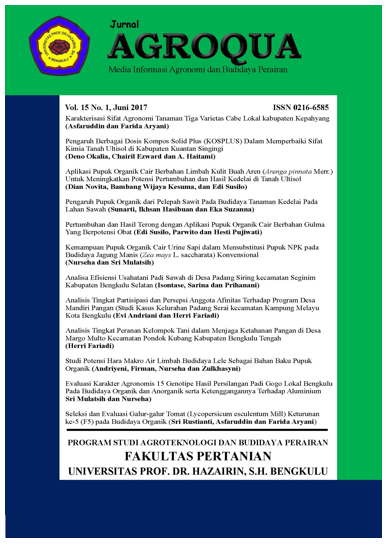PENGARUH PERENDAMAN BENIH MUCUNA (Mucuna bracteata) DALAM BEBERAPA KONSENTRASI H2SO4 TERHADAP PEMATAHAN DORMANSI
DOI:
https://doi.org/10.32663/ja.v17i2.977Keywords:
land, LCC, scarification, seed coat, weedsAbstract
Mucuna bracteata is a Legume Cover Crop (LCC) which has many advantages compared to other LCC. The generative propagation of M. bracteata is very difficult because of the seed coat is hard and thick, so that it has a long dormancy period and low germination. Germination without seed treatment, the germination ability only 12% to 18.33%. The efforts are made to break the seed dormancy by soaking the seeds in the sulfuric acid (H2SO4) to remove the lignin layer in the seed coat. The present study objective was to determine the appropriate concentration of H2SO4 for breaking dormancy of M. bracteata seeds. This research was conducted at the Laboratory of the 3rd Campus Andalas University, Dharmasraya, in April to June 2019 using a Completely Randomized Design (CRD) consisted of 3 treatments with 4 replications. The seed treatments were some concentrations of H2SO4 namely 3%, 4%, and 5%. The observed variables were T50 break dormancy period, germination ability, abnormal germination, dead seed, first count test, index value, and maximum growth potential. The observation data were analyzed by an F test at a 5% level, followed by the Duncan’s New Multiple Range Test (DNMRT) at a level of 5%. The results showed that soaking of M. bracteata seeds in H2SO4 with a concentration of 3% was the best treatment, a T50 value of 8.75 days after planting with a germination capacity of 78.50%.
References
Downloads
Published
Issue
Section
License
Authors who publish with this journal agree to the following terms:
- Authors grant the journal right of first publication with the work simultaneously licensed under a Creative Commons Attribution 4.0 Internasional (CC BY 4.0) Licence that allows others to use and share the work with an acknowledgment of the work's authorship and initial publication in this journal.
- The author(s) still hold the copyright of his/her/their work and retain publishing rights without restrictions such as (but not limited to) patent right, lecture, book and reproduce the article for own purposes.
















